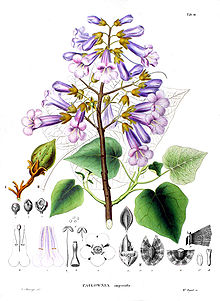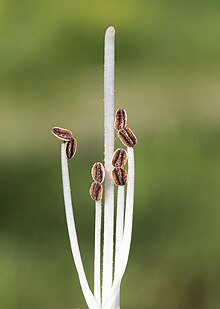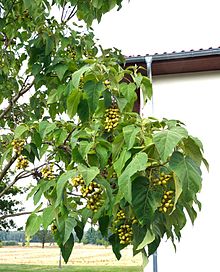Paulownia
| Paulownia | ||||||||||||
|---|---|---|---|---|---|---|---|---|---|---|---|---|

Bluebell tree ( Paulownia tomentosa ) in full bloom |
||||||||||||
| Systematics | ||||||||||||
|
||||||||||||
| Scientific name of the family | ||||||||||||
| Paulowniaceae | ||||||||||||
| Nakai | ||||||||||||
| Scientific name of the genus | ||||||||||||
| Paulownia | ||||||||||||
| Siebold & Zucc. |
The paulownia ( Paulownia ) are the only genus of the plant family bluebell plants (Paulowniaceae). The seven or so species are common in East Asia.
description



Appearance and leaves
The Paulownia species are deciduous or - in a tropical climate - evergreen trees . Even at a young age , the smooth bark has conspicuous lenticels that expand lengthways over time. The branches have no terminal buds.
The constantly against arranged on the branches leaves consist of a long petiole and a simple leaf blade. The leaf blade is undivided or slightly three- to five-lobed with wavy leaf margins, which are often sawn on young trees.
Inflorescences and flowers
The large total inflorescence is a pyramidal to cylindrical thyrsus with mostly three to five-flowered, (one to eight-flowered) zymous partial inflorescences. There may be an inflorescence stem.
The hermaphrodite, zygomorphic flowers are quite large with lengths of 5 to 7 centimeters and five-fold with a double flower envelope . Paulownia fortunei has the largest flowers with lengths of 8 to 12 centimeters and the smallest Paulownia kawakamii with lengths of 3 to 5 centimeters. The five hairy sepals are bell-shaped to inverted-conical fused together with almost identical calyx teeth, the upper one being about larger. The five white to purple-colored petals are fused together funnel-shaped-bell-shaped to tubular-funnel-shaped. The corolla tube is narrowed and slightly curved at its base. The corolla is two-lipped with a longer, three-lobed lower lip and a shorter two-lobed upper lip. The four stamens have grown on the inside of the corolla, two of which are longer and two are shorter and do not protrude from the corolla . Sometimes there are also five stamens. The stamens are twisted near their base. The above constant, bicompartmental ovary carries at the top of the stylus , which is about as long as the stamens. Special "tube scars " are formed, here the scars are hidden in a cavity at the end of the stylus.
Fruits and seeds
The loculicidal capsule fruits open with two or incompletely four valves and contain numerous seeds. The small seeds have little endosperm and are membranous.

Systematics and distribution
The first description of the genus Paulownia took place in 1835 with the type species Paulownia imperialis (now a synonym of Paulownia tomentosa var. Tomentosa ) by Philipp Franz von Siebold and Joseph Gerhard Zuccarini in Flora Japonica , 1, 27. The genus name Paulownia honors the Russian Czar's daughter Anna Pavlovna . The Paulowniaceae family was first mentioned in 1949 by Takenoshin Nakai in the Journal of Japanese Botany , 24, p. 13. The genus Paulownia has long been part of the figwort family (Scrophulariaceae). According to more recent findings obtained with molecular biological methods, however, it represents the only genus of the independent bluebell family (Paulowniaceae).
All paulownia species are native to eastern and central China , three of them also from Taiwan . One species, Paulownia fortunei , occurs in the south as far as Laos and northern Vietnam .
There are about seven Paulownia typologies:
- Paulownia catalpifolia T.Gong ex DYHong : This endemic thrives at low altitudes only in Zou Xian in the Chinese province of Shandong .
- Paulownia elongata S.Y.Hu : It grows wild or cultivated at low altitudes in the Chinese provinces of Anhui , Hebei , Henan , Hubei , Jiangsu , Shaanxi , Shandong and Shanxi .
- Paulownia fargesii Franchet : It grows wild or cultivated in Vietnam and in the Chinese provinces of Guizhou , Hubei , Hunan , Sichuan and Yunnan .
- Paulownia fortunei (sailor) Hemsley : It grows wild or cultivated in Laos, Vietnam, Taiwan and in the Chinese provinces of Anhui, Fujian , Guangdong , Guangxi , Guizhou, Hubei, Hunan, Jiangxi , Sichuan, Yunnan and Zhejiang .
- Paulownia kawakamii T.Ito : It thrives at altitudes of 200 to 1500 meters in Taiwan and in the Chinese provinces of Fujian, Guangdong, Guangxi, Guizhou, Hubei, Hunan, Jiangxi and Zhejiang.
- Paulownia taiwaniana T.W.Hu & HJChang : This species was identified in 1991 and 1994 under the name Paulownia × taiwaniana T.W.Hu & HJChangals as a natural hybrid between Paulownia fortunei and Paulownia kawakamii . But it is listed in 1998 in the Flora of China and all later works with the valid name Paulownia taiwaniana . Another synonym is Paulownia australis Gong Tong . It thrives in secondary forests below 1200 meters in Taiwan and in the Chinese provinces of Fujian, Guangdong, Hunan and Zhejiang.
-
Bluebell tree , emperor paulownia ( Paulownia tomentosa ( Thunb. ) Steudel ):
- Paulownia tomentosa (Thunb.) Steudel var. Tomentosa he usually thrives cultured below about 1800 meters in the Chinese provinces of Anhui, Hebei, Henan, Hubei, Hunan, Jiangsu, Jiangxi, southern Liaoning , Shaanxi, Shandong, Shanxi. It is used as an ornamental plant in the temperate latitudes.
- Paulownia tomentosa var. Tsinlingensis (Pai) Gong Tong : It grows wild or cultivated at altitudes below 1700 meters in the Chinese provinces of Gansu, Henan, Hubei, Shaanxi, Shandong, Shanxi and northern Sichuan.
use
The bluebell tree ( Paulownia tomentosa ) is used as an ornamental and fast-growing crop in regions with favorable climatic conditions in Japan , Europe and North America . Its wood is almost as light as balsa and relatively stiff. It is used as a light intermediate layer , for example in furniture construction , for musical instruments or as a core material for surfboards . Some traditional pieces of furniture are also made from paulownia in Japan.
Paulownias have also been grown in Germany in plantations for timber production since 2012 . The German wood producers also refer to this tree in Japanese as "Kiri tree".
symbolism
In Japan the "5-7-5 Paulownie" - originally the coat of arms of the Ashikaga princes - is the coat of arms of the Japanese Prime Minister or the government. The inflorescence of the paulownia also adorns the Japanese 500 yen coin.
swell
- The family of Paulowniaceae in APWebsite . (Sections Description and Systematics)
- https://www.holzvomfach.de/fachwissen-holz/holz-abc/kiri/
- Deyuan Hong, Hanbi Yang, Cun-li Jin, Manfred A. Fischer, Noel H. Holmgren, Robert R. Mill: Scrophulariaceae. : Paulownia , p. 8: - online with the same text as the printed work , In: Wu Zheng-yi, Peter H. Raven (Ed.): Flora of China. Volume 18: Scrophulariaceae through Gesneriaceae , Science Press and Missouri Botanical Garden Press, Beijing and St. Louis 1998, ISBN 0-915279-55-X . (Sections Description, Distribution and Systematics)
Individual evidence
- ↑ Claudia Erbar, Christoph Gülden: Ontogeny of the flowers in Paulownia tomentosa - A contribution to the recognition of the resurrected monogeneric family Paulowniaceae. In: Flora - Morphology, Distribution, Functional Ecology of Plants. Volume 206, Issue 3, 2011, pp. 205–218, doi : 10.1016 / j.flora.2010.05.003 .
- ^ First description scanned in in the Flora Japonica 1835.
- ^ Paulownia at Tropicos.org. Missouri Botanical Garden, St. Louis
- ↑ Tsan-Piao Lin, Ying-Seng Wang: Paulownia taiwaniana, a hybrid between P. fortunei and P. kawakamii (Scrophulariaceae). In: Plant Systematics and Evolution , Volume 178, 1991, No. 3-4, pp. 259-269.
- ↑ WY Wang, RC Pai, CC Lai, TP Lin: Molecular evidence for the hybrid origin of Paulownia Taiwaniana based on RAPD markers and RFLP of chloroplast DNA , In: TAG Theoretical and Applied Genetics , Volume 89, 1994, No. 2-3, pp. 271-275.
- ↑ Japanology Plus: Japanology Plus - Wood: Culture. March 7, 2019, accessed March 12, 2019 .
- ↑ Bonner Generalanzeiger : Kiribaum plantation in Hoholz .



